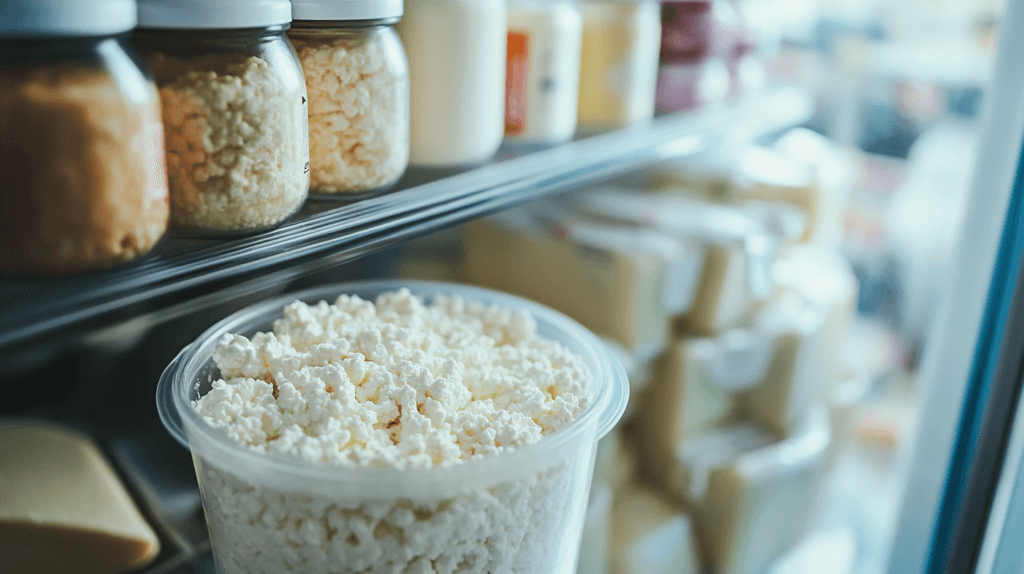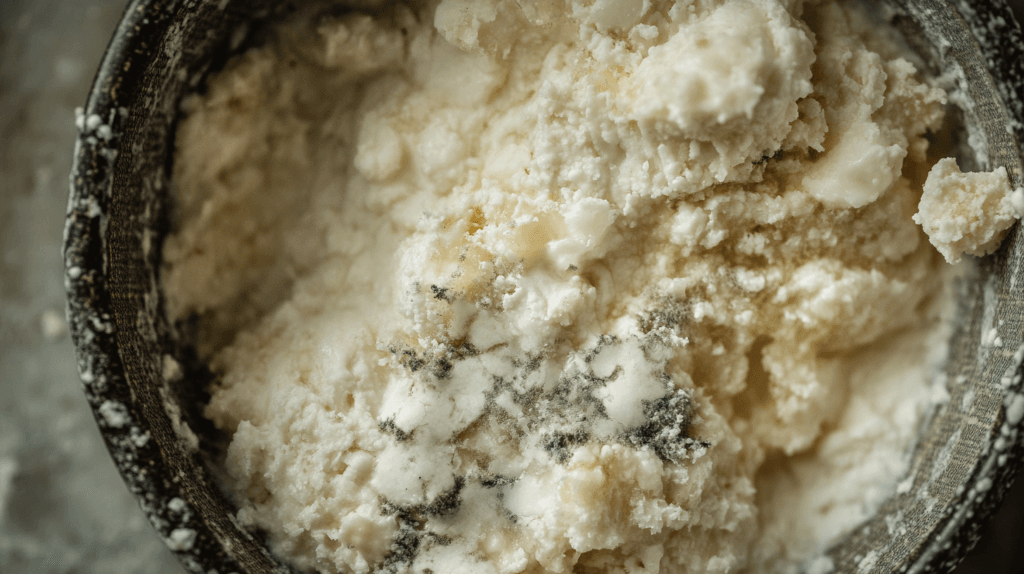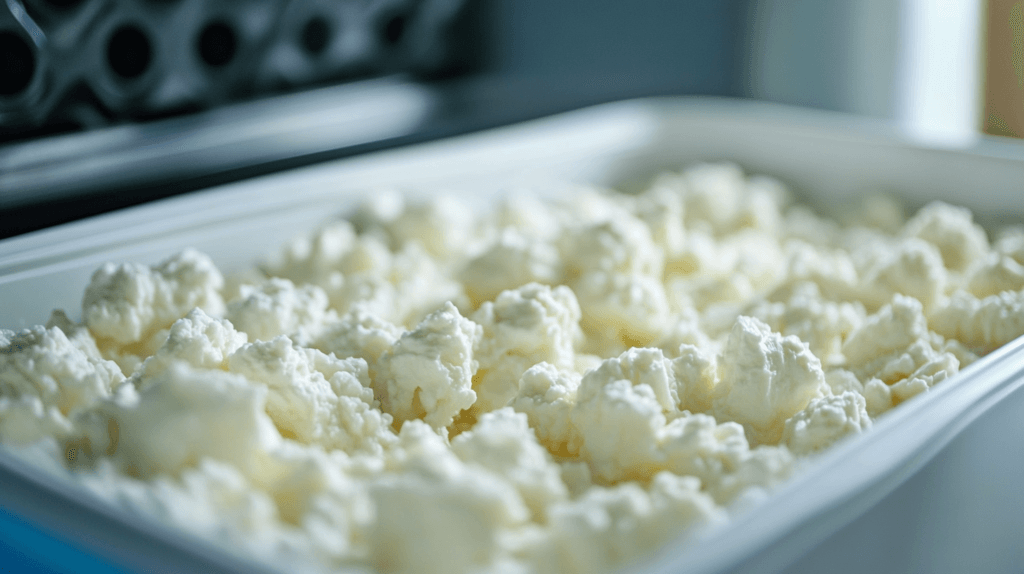Introduction
Cottage cheese is a well-known dairy product, prized for its creamy texture and high nutritional value. It’s a versatile ingredient, enjoyed on its own or as part of a variety of recipes. However, like most dairy products, cottage cheese has a limited shelf life, and understanding how long it lasts after opening is crucial to avoid spoilage and food waste. Proper storage techniques can significantly impact its longevity, ensuring you can enjoy it safely and without compromising on taste or quality.
What Is Cottage Cheese?
Definition and Key Characteristics
Cottage cheese is a soft, fresh cheese made from curds of cow’s milk that has been heated to kill germs. Unlike older cheeses, it doesn’t go through an aging process, so it has a mild flavor and a slightly tangy taste. You can find it in different types, like full-fat, low-fat, and fat-free, to match various diets.
How It Is Made
To make cottage cheese, you curdle milk with an acidic agent like vinegar or lemon juice. Afterward, you drain the curds without pressing them, which helps them retain some whey. This gives cottage cheese its characteristic creamy consistency.
Nutritional Value
Cottage cheese is packed with protein, calcium, and other important nutrients, making it popular with people who care about health. It’s low in carbs and calories, which makes it great for weight control and high-protein diets.
Shelf Life of Cottage Cheese
General Shelf Life Unopened
Unopened cottage cheese usually stays fresh for 7–10 days past the expiration date if kept in the fridge. The sealed package keeps it safe by blocking out harmful germs.
Shelf Life After Opening
Once opened, cottage cheese generally remains fresh for 5–7 days if stored properly in the refrigerator. This timeframe may vary depending on factors like temperature consistency and exposure to air or moisture.
Factors Affecting Longevity
- Storage Temperature: Cottage cheese must be kept at a consistent temperature of 40°F (4°C) or below.
- Exposure to Air: Contact with air can accelerate spoilage, leading to bacterial growth.
- Contamination Risks: Using dirty utensils or hands can introduce harmful bacteria, shortening its shelf life.
Storage Methods

Proper storage is essential to maximize the freshness and safety of cottage cheese after opening. Below are detailed storage methods and best practices to ensure your cottage cheese stays fresh and safe to eat for as long as possible.
Proper Refrigeration
Refrigeration is the most critical factor in maintaining the quality of cottage cheese. Always store it at or below 40°F (4°C). Here’s how to make the most of your refrigerator setup:
- Location in the Fridge: Place cottage cheese in the coldest part of the refrigerator, which is typically the back of the middle or bottom shelf. Avoid storing it in the refrigerator door, where temperatures fluctuate frequently due to opening and closing.
- Consistent Temperature: Keep a refrigerator thermometer to ensure the temperature stays within the safe range for dairy products. Consistent cold temperatures help slow bacterial growth and preserve the freshness of the cheese.
- Avoid Freezing in the Fridge: While refrigeration is necessary, do not let cottage cheese accidentally freeze by storing it too close to the cooling vents. Freezing can alter the texture and flavor, making it less enjoyable to eat fresh.
Airtight Containers
Air exposure can lead to spoilage by allowing bacteria and mold to grow. To combat this, proper sealing is essential:
- Use the Original Packaging: If the lid of the original container is resealable and in good condition, it is sufficient for storage. Ensure it is tightly closed after each use.
- Transfer to an Airtight Container: If you find the original packaging damaged or hard to reseal, move the cottage cheese into a clean, airtight container. This step minimizes air exposure and keeps the cheese from absorbing odors from other foods in the refrigerator.
- Wrap for Extra Protection: For added freshness, consider covering the container with a layer of plastic wrap or aluminum foil before closing the lid. This creates an additional barrier against air and moisture.
Importance of Temperature Consistency
Temperature fluctuations can rapidly degrade the quality of cottage cheese. To maintain consistency:
- Refrigerate Immediately After Use: Always return cottage cheese to the refrigerator immediately after serving. Leaving it out for even short periods can cause the temperature to rise, increasing the risk of spoilage.
- Avoid Frequent Openings: Each time you open the container, warm air enters and disrupts the cold environment inside. To preserve freshness, try to minimize how often you open it.
- Transport with Care: If you need to transport cottage cheese (e.g., to a picnic or another location), use a cooler with ice packs to maintain a safe temperature.
Preventing Cross-Contamination
Contamination can shorten the shelf life of cottage cheese significantly. Follow these tips to avoid introducing bacteria:
- Use Clean Utensils: Always use a clean spoon or fork to scoop out cottage cheese. Dirty utensils can introduce bacteria, accelerating spoilage.
- Avoid Double Dipping: Do not eat directly from the container. This introduces saliva and microbes into the cheese, increasing the risk of contamination.
- Seal Immediately After Serving: Close the container tightly after taking out the amount you need. Prolonged exposure to air can dry out the cheese and promote bacterial growth.
Extra Tips for Longer Storage
- Rotate Your Stock: Practice the “first in, first out” rule for dairy products. Use older containers first to avoid accidental spoilage of opened cottage cheese.
- Inspect Before Storing: If you notice excessive liquid separation upon opening, drain it before refrigerating to prevent bacterial growth in the liquid.
- Store Away From Strong Odors: Cottage cheese can absorb odors from other foods in the fridge. Keep it away from pungent items like onions, garlic, or fish.
By following these detailed storage methods, you can keep your cottage cheese fresh and safe to consume, maximizing its shelf life and reducing food waste.
Signs of Spoilage

Visual Changes
Spoiled cottage cheese may develop mold, discoloration, or a watery layer separating from the curds. If you notice any of these changes, it’s best to discard it.
Odor Changes
Fresh cottage cheese has a mild and tangy scent. A sour or rancid smell indicates that it’s no longer safe to consume.
Texture and Taste Alterations
A grainy or excessively slimy texture, along with a sharp or unpleasant taste, are clear signs of spoilage.
Extending the Shelf Life
Best Practices for Storage
To make your cottage cheese last longer, ensure that it’s always refrigerated immediately after use. Close the lid tightly after each serving to reduce air exposure. If the original seal has been compromised, transferring the cottage cheese to a clean, airtight container is recommended.
Tips for Preventing Contamination
- Use Clean Utensils: Always use a clean spoon or fork when scooping cottage cheese to avoid introducing bacteria.
- Avoid Double Dipping: Refrain from eating directly from the container, as this increases the risk of cross-contamination.
- Check Packaging Integrity: Inspect the packaging before purchase to ensure it is sealed properly.
Does the Type of Cottage Cheese Matter?
Low-Fat vs. Full-Fat
The fat content can slightly influence the shelf life. Low-fat cottage cheese may spoil faster due to its higher moisture content, while full-fat versions tend to remain fresh slightly longer.
Organic vs. Regular
Organic cottage cheese is often free of preservatives, which can make it more perishable than conventional varieties. Regular versions with stabilizers or preservatives might last longer, but always check the label for specifics.
Impact of Additives on Shelf Life
Some cottage cheese products include additives to enhance texture or prolong freshness. These ingredients can slightly extend shelf life but may affect the natural taste.
Cottage Cheese and Food Safety
Understanding Expiration Dates
The date printed on cottage cheese containers is usually a “sell-by” or “best-by” date, indicating peak quality rather than safety. While unopened cottage cheese can be consumed a few days past this date, always inspect it for signs of spoilage before eating.
Food Safety Guidelines for Dairy Products
- Keep cottage cheese refrigerated at all times.
- Discard leftovers left at room temperature for over 2 hours.
- Store at the appropriate temperature of 40°F (4°C) or below to inhibit bacterial growth.
Impact of Packaging
Original Packaging vs. Transfer to Another Container
The original packaging is designed to maintain freshness for as long as possible. However, once opened, resealing it tightly or transferring the cheese to an airtight container is crucial for extending shelf life.
How to Seal Properly
If you’re keeping the cheese in its original packaging, use plastic wrap or aluminum foil to create a tight seal. For containers without resealable lids, an additional layer of protection is essential.
Freezing Cottage Cheese
Is Freezing Recommended?
While it’s possible to freeze cottage cheese, the texture may change upon thawing. Freezing is more suitable if you plan to use it in cooked dishes where the altered texture won’t be noticeable.
How to Freeze and Thaw Properly
- Freezing: Place the cottage cheese in a freezer-safe, airtight container. Leave some room for expansion and freeze for up to 2–3 months.
- Thawing: Defrost in the refrigerator overnight and stir well before using. Avoid refreezing once thawed.
What to Do With Expiring Cottage Cheese?
Creative Recipe Ideas
- Smoothies: Blend cottage cheese with fruits and honey for a creamy, protein-packed smoothie.
- Pancakes: Add it to pancake batter for a fluffy, tangy twist.
- Casseroles: Use it as a creamy base for baked dishes like lasagna or pasta bakes.
Using Cottage Cheese Before It Spoils
When nearing its expiration, incorporate cottage cheese into recipes that can mask minor textural changes, such as baked goods or blended dips.
Comparing Shelf Life With Other Dairy Products
How Cottage Cheese Compares to Yogurt
Cottage cheese generally has a shorter shelf life than yogurt due to its higher moisture content and lack of active cultures. Yogurt contains probiotics that naturally inhibit bacterial growth, allowing it to stay fresh longer when stored properly.
Cottage Cheese vs. Cream Cheese
Cream cheese, being denser and lower in moisture, tends to last longer than cottage cheese after opening. However, both products require refrigeration and similar storage precautions to maintain freshness.
Other Fresh Cheeses
Soft cheeses like ricotta and mascarpone are comparable to cottage cheese in terms of shelf life, usually lasting around a week after opening if refrigerated correctly.
FAQs About Cottage Cheese Storage
Can You Eat Cottage Cheese Past Its Expiration Date?
Yes, unopened cottage cheese can often be safely consumed a few days past its expiration date if stored properly. However, always inspect for spoilage signs like discoloration, an off smell, or a sour taste before consuming. For tips on freezing foods like cottage cheese, check out “Can You Freeze Cornbread?”.
What Happens If You Eat Spoiled Cottage Cheese?
Eating spoiled cottage cheese can lead to foodborne illnesses, with symptoms like nausea, stomach cramps, diarrhea, and vomiting. It’s essential to discard any cottage cheese that appears or smells off.
How Long Does Cottage Cheese Last in the Fridge After Opening?
After opening, cottage cheese typically lasts 5–7 days when stored in an airtight container in the refrigerator at 40°F (4°C) or below. Discover additional insights into shelf life in “Why Does Brioche Last So Long?”.
Can You Freeze Cottage Cheese to Extend Its Shelf Life?
Yes, freezing cottage cheese can extend its usability for up to 2–3 months. However, note that the texture may change, making it better suited for cooking rather than eating fresh. For freezing techniques and recipes, refer to “Can I Freeze Cottage Cheese?”.
Is It Safe to Leave Cottage Cheese Out Overnight?
No, cottage cheese should not be left at room temperature for more than 2 hours. Beyond this point, harmful bacteria can grow, making it unsafe to eat. Learn how to integrate cottage cheese safely into your diet with the help of “How Much Cottage Cheese Should I Eat a Day?”.
How Can You Tell If Cottage Cheese Has Gone Bad?
Signs of spoilage include mold, a sour or rancid odor, a slimy texture, or a sour taste. If you observe any of these, discard the product immediately.
Common Myths About Cottage Cheese Shelf Life
Myth 1: “Cottage Cheese Lasts Forever If Refrigerated”
While proper refrigeration is essential, cottage cheese still has a limited shelf life. Even when refrigerated, it should be consumed within the recommended timeframe of 5–7 days after opening.
Myth 2: “Freezing Doesn’t Affect the Quality”
Freezing can preserve cottage cheese, but it often alters its texture, making it less creamy and more crumbly. This change may not be ideal for all uses.
Myth 3: “The Expiration Date Is Absolute”
The expiration date is a guideline for peak quality, not an absolute indicator of safety. Cottage cheese may still be safe to eat shortly after this date if it shows no signs of spoilage.
Expert Tips for Maximizing Freshness
- Store Strategically: Place cottage cheese in the coldest part of the refrigerator, typically at the back of the middle shelf.
- Check Your Fridge Temperature: Use a thermometer to ensure your fridge maintains a consistent temperature of 40°F (4°C) or lower.
- Label and Date: If transferring cottage cheese to a new container, label it with the date of opening to keep track of freshness.
- Consume Quickly: Plan your meals to include cottage cheese shortly after opening to avoid waste.
- Use Freezing Wisely: Only freeze cottage cheese if you intend to use it in cooked dishes where textural changes won’t matter.
Conclusion
Cottage cheese is a versatile and nutritious dairy product, lasting about 5–7 days after opening with proper storage. Follow these tips and explore creative ways to use it in cooking to minimize waste and enjoy it safely. For more inspiration, check out “Cottage Cheese Recipes” and optimize your intake with advice from “How Much Cottage Cheese Should I Eat a Day?”.

